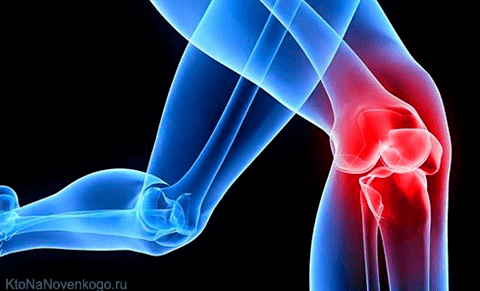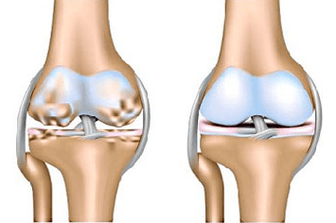A joint disease ("Arthr-joint, " -Sosis "dinease) comes from the ancient Greek" arthrosis ". Sometimes it is also referred to osteoarthrosis or deforming osteoarthritis (from the ancient Greek "osteon" bone).
It will be wrong to call osteoarthritis as a disease - this is the name of a whole group of conditions that includes many diagnoses.
Any disease of a joint, regardless of the cause, can be referred to as osteoarthritis, but this does not indicate the doctor or the patient: the word "arthrosis" is not associated with the cause of the disease or treatment, but only with some symptoms.
The word "arthrosis" is very similar to another term: "This is arthritis. " Both describe the damage to the joints, both are often associated with pain in the joint, but have significant differences.

Typically, arthritis is a disease associated with inflammation in the joint: infection, hereditary or autoimmune diseases lead to the beginning of arthritis. The main manifestations include pain, color change, swelling in the area of the inflamed joint.
In the case of osteoarthritis, manifestations are less noticeable and the causes are completely different.
How the joint works (knees and others)
The musculoskeletal system needs a person for active movements in the room. The bones are a rigid frame, muscles - their driving force and joints - the place of the mobile connection of bones.
In the structure of the joint there are always two ends of the neighboring bones that can move relatively with the help of the muscles and a small gap between them. This joint column is filled with a special lubricant synovial fluid. It is required for the nutrition of the cartilage: it does not contain vessels in it, so it takes all nutrients from Synovia.
The jointing of each bone is covered with cartilage to protect the bone tissue from friction. The cartilage also helps to "extinguish" the vibration and a sharp mechanical strain: for example, the knee and joints of the foot take most of the energy from the foot root onto the ground while walking.
Restoration of this cartilage is a long and complex process that does not always end successfully.
All joints are limited by a capsule - a film that contains the articular fluid does not allow you to spread. Almost all joints are supported by ligaments that do not move it too much for the neighboring bones and in the wrong direction.
Why and how arthrosis develops
There are many reasons for the start of osteoarthritis, in some cases it is a combination of factors, and sometimes it is impossible to establish the cause.
There are three main causes and more than a dozen additional. Most popular:
- Joint injury;
- Congenital common anomalies (dysplasia);
- The result of inflammation (arthritis) for any reason;
- Age (usually more than 50 years);
- Violation of the metabolism (trace elements), obesity;
- Excessive stress on the connection.
The development of osteoarthritis is divided into three stages:
- Initially. There are no obvious signs, it is difficult to find it. The composition of the synovial fluid changes, its function worsens.
- Pain. Complaints and structural changes occur in the form of bone growth - osteophytes.
- Heavy osteoarthritis. A significant decrease in the function of the joint is added: the movements are reduced or completely disappeared; The connection is deformed and the appearance of the limbs changes.
First, the structure of the cartilage is disturbed: it is thickened due to a change in the composition of the synovie or for another reason. The swelling of the cartilage material worsens its diet, so that the cartilage becomes thinner over time.
Then the cartilage almost disappears in the most loaded parts of the connection or becomes too narrow. In return, the growth of the bone begins - the appearance of osteophytes (bone tips).
At the end of the disease, the growth of the bone is so pronounced that it limits the movement to ancyloses - the complete immobility of the joint.
Symptoms of arthrosis
First manifestations: periodic pain after significant physical activity. Then the morning stiffness connects - after it is woken up for a few minutes (up to 30) (up to 30), the connection by an elastic bandage seems to be connected: movements are possible, but difficult.
Later symptoms:
- Pain in the palpation of the joint;
- Thickening of the bone in the joint;
- Restriction on movement;
- increased pain in less significant physical activity;
- Deformation of the limb.
Most often arthrosis is a disease of the large joints of the legs (knees, hips) and hands (shoulder). The fuck connections are less common.
Degenerative processes in the joint can still manifest themselves in the form of unusual noises during movement: crunch, cracking, shock.
Diagnosis
As with another illness, it begins with the collection of an anamnesis - the history of the disease.
It is particularly important for the doctor to find out whether the presence of risk factors is available (injuries, arthritis, innate defects, chronic diseases).
After the conversation and checking the joint, additional methods are required: tests and instrumental examination.

The main study on diagnosis of osteoarthritis is radiography.
The picture will clearly see the main changes in the joint: reduction of the joint gap, bone growth, deformation. In the early stages, small osteophytes along the edge of the joint can be observed, and in late uneven bone growth along the entire joint column becomes noticeable.
The ultrasound examination (ultrasound) is an additional method with which the thickness of the cartilage will determine in the earliest stages of osteoarthritis. The arthroscopy is less common: a surgeon puts a small camera directly into the joint column and receives the image of the cartilage.
Treatment of osteoarthritis
It is impossible to heal osteoarthritis completely and to return the joint to the original state. The correct combination of several methods will only slow the development of osteoarthritis, but "the previous youth return" will not work.
The main tasks for the treatment of deforming osteoarthritis of the knee or hip joint:
- moderate physical activity (running, walking, sitting position);
- Special exercises, training therapy (physiotherapy exercises);
- Diet;
- Drug treatment;
- Surgical treatment.
With the arthrosis of the shoulder joint or another localization, the principles do not change except the correction of the load on the specific joint.
Physical activity and exercises are selected by a doctor with an orthopedic traumatologist. The diet usually includes the enrichment of diet with unsaturated fatty acids, a variety of proteins, moderately limited carbohydrates (especially simple, they are "fast").
The rejection of poor habits (smoking, alcohol in any amount) significantly slows down the development of osteoarthritis. Diet also depends on the cause of the disease, chronic diseases. You don't have to take any dietary supplements.
Pharmaceutical therapy - painkillers. Not -steroidal anti -steroid drugs are used more frequently. The choice of suitable slopes depends on the presence of chronic diseases and the planned duration of administration. Corticosteeroids (glucocorticoids, steroid medication) are less common.
Doctors very often prescribe chondroprotectors - medication that contains some of the Molecules important for cartilage. In most cases, such drugs have no influence on the joint, especially on tablet forms and ointments.
It is extremely rare that such drugs can be really necessary and can achieve a real effect: When examining the intra -karticular liquid, you can check your quantity and with a deficiency in the joint (Intra -Karticular injection).
Conclusions
Arthrosis is a degenerative joint disease associated with mechanical damage to the cartilage and the growth of bone tissue. It usually develops in people over 50 years after joint injuries or long -term overload.
It manifests itself through pain after loading, morning stiffness and crunch.


























